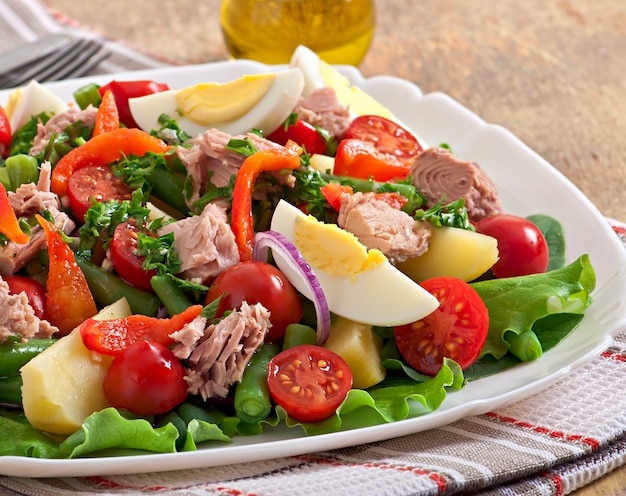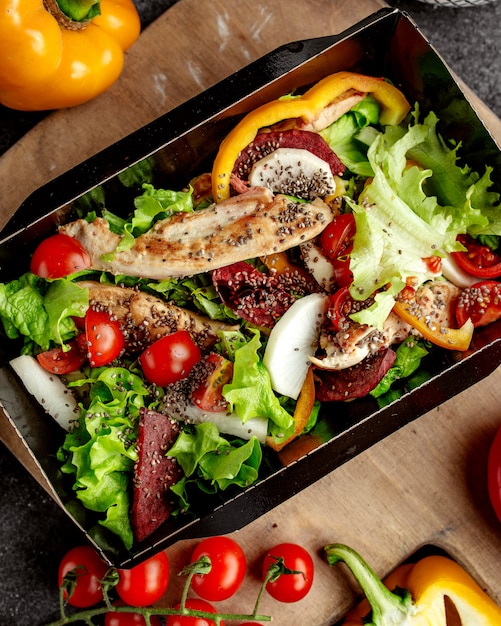Are barbecue salads healthy?
Barbecue season is upon us, and many of us are looking forward to enjoying delicious grilled food in the summer sunshine. While the main focus is often on meats and burgers, salads also play a significant role in any barbecue spread. But are barbecue salads healthy? Let’s explore this question and delve into the nutritional benefits of these summertime favorites.
The Nutritional Benefits of Barbecue Salads
Barbecue salads can be a nutritious addition to your meal, providing a range of essential vitamins, minerals, and fiber. These salads are often packed with fresh vegetables, fruits, and leafy greens, which offer numerous health benefits. They are low in calories and high in nutrients, making them a great choice for those looking to maintain a balanced diet.
Fresh and Vibrant Ingredients: Barbecue salads typically include a variety of colorful vegetables like tomatoes, cucumbers, bell peppers, and carrots. These veggies are rich in antioxidants that help protect our cells from damage. Additionally, they provide essential vitamins, such as vitamin C and vitamin A, which are crucial for a healthy immune system and good vision.
Nutrient-Packed Leafy Greens: Many barbecue salads feature leafy greens like spinach, arugula, or kale. These greens are an excellent source of iron, calcium, and vitamin K. They also contain dietary fiber that aids digestion and promotes feelings of fullness, making them a satisfying addition to your plate.
The Impact of Dressings and Toppings
While the base ingredients of barbecue salads offer numerous health benefits, it’s essential to consider the impact of dressings and toppings. Creamy dressings and high-fat toppings, such as bacon bits or cheese, can significantly increase the calorie and fat content of the salad. However, there are healthier alternatives available, such as vinaigrettes made with olive oil or yogurt-based dressings.
Portion Size and Moderation: It’s also crucial to be mindful of portion sizes when enjoying barbecue salads. While they offer many health benefits, consuming large quantities could lead to an excessive calorie intake. Balancing your portions with other barbecue options, such as lean meats and grilled vegetables, can help create a well-rounded and healthy meal.
Expert Opinions on Barbecue Salads
“Barbecue salads can be an excellent way to incorporate more fresh vegetables and fruits into your diet,” says nutritionist Dr. Sarah Thompson. “They provide essential nutrients and hydration, particularly in the summer months, while adding color and vibrancy to your plate.”
Dr. Thompson also advises, “When choosing dressings, opt for lighter options that are low in saturated fats and added sugars. Homemade dressings using olive oil or vinegar can be a healthier alternative to store-bought varieties.”
Summing it Up
In conclusion, barbecue salads can indeed be a healthy addition to your summer meals. Packed with fresh and vibrant ingredients, these salads offer a range of nutritional benefits. By opting for lighter dressings and practicing portion control, you can enjoy a delicious and nutritious barbecue salad that complements your overall diet. So, next time you fire up the grill, don’t forget to include some refreshing salads to make your barbecue spread complete!
What are the Nutritional Benefits of Popular Barbecue Salads?
Introduction
Barbecues are a quintessential part of British summers, and alongside the sizzling burgers and juicy steaks, salads have become an integral part of any outdoor feast. Not only are they refreshing and delicious, but popular barbecue salads also offer a range of nutritional benefits that make them a healthy addition to your plate. Let’s explore some of these benefits in more detail.
Fiber-Rich Ingredients
Many popular barbecue salads are packed with fiber-rich ingredients such as leafy greens, cruciferous vegetables, and whole grains. These ingredients not only contribute to the overall volume and texture of the salad but also provide essential nutrients and promote digestive health. Fiber helps regulate bowel movements, reduces the risk of constipation, and can contribute to maintaining a healthy weight.
Vitamins and Minerals
Barbecue salads often feature an array of colorful vegetables, which are a great source of vitamins and minerals. For example, tomatoes provide vitamin C and potassium, while carrots are rich in beta-carotene and vitamin K. Incorporating a variety of vegetables into your salad ensures you receive a wide range of essential nutrients, supporting overall health and wellbeing.
Heart-Healthy Fats
Some popular barbecue salads include healthy fats, such as avocado, nuts, and seeds. These ingredients not only add flavor and texture but also provide monounsaturated fats, which are beneficial for heart health. The consumption of these fats has been linked to lower cholesterol levels and reduced risk of heart disease.
Protein-Packed Options
Whether it’s grilled chicken, tofu, or chickpeas, popular barbecue salads offer protein-packed options that can help you meet your daily protein requirements. Protein is essential for muscle repair and growth, as well as providing a feeling of satiety. Including a source of protein in your salad can help keep you satisfied throughout the meal.
Which Salads Have the Least Calories?
When trying to maintain a healthy diet or lose weight, salads can be a great option. They are usually packed with vitamins, minerals, and fiber while being low in calories. However, not all salads are created equal. Some can be surprisingly high in calories due to their dressings or toppings. If you’re looking for salads with the least calories, here are some options to consider:
1. Green Salad
A simple green salad made with leafy greens such as lettuce, spinach, or arugula is a fantastic low-calorie option. These greens are rich in nutrients and provide bulk without adding a lot of calories. To add flavor, you can include a variety of colorful vegetables like tomatoes, cucumbers, or bell peppers.
2. Greek Salad
A traditional Greek salad is another low-calorie choice. It typically includes fresh vegetables like tomatoes, cucumbers, onions, and bell peppers, along with feta cheese and olives. The combination of flavors creates a delicious and satisfying salad that is light on the calories.
3. Cucumber and Tomato Salad
If you’re looking for a refreshing and low-calorie option, a cucumber and tomato salad is an excellent choice. It’s as simple as slicing cucumbers and tomatoes, then tossing them together with some olive oil, vinegar, and herbs. This salad is not only low in calories but also hydrating and full of antioxidants.
4. Chicken Salad
A chicken salad can be a filling and nutritious meal option. To keep it low in calories, opt for grilled or baked chicken breast instead of breaded or fried. Combine it with a mix of leafy greens, vegetables, and a light dressing. You can also add some sliced almonds or seeds for added texture.
5. Quinoa Salad
A quinoa salad is a great choice for those looking to include some plant-based protein in their diet. Quinoa is high in protein, fiber, and various essential nutrients. Combine it with your choice of vegetables, herbs, and a light vinaigrette to create a delicious and low-calorie salad.
“Salads can be a great way to incorporate nutrient-rich vegetables into your diet while keeping calories in check.”
While these salads are generally low in calories, it’s important to pay attention to the dressing and toppings you choose. Creamy dressings, croutons, bacon, or excessive amounts of cheese can quickly increase the calorie content. Opt for lighter dressings like balsamic vinegar or lemon juice and limit the amount of high-calorie toppings to keep your salad on the healthier side.
Here’s a simple table displaying the approximate calorie counts for each salad:
| Salad | Approximate Calories |
|---|---|
| Green Salad | 50-100 calories |
| Greek Salad | 100-200 calories |
| Cucumber and Tomato Salad | 50-80 calories |
| Chicken Salad | 150-250 calories |
| Quinoa Salad | 200-300 calories |
Remember, the calorie content of each salad may vary depending on portion sizes and specific ingredients used. It’s always a good idea to consult nutritional information or use a calorie-tracking app if you’re closely monitoring your intake.
Incorporating low-calorie salads into your diet can be a satisfying way to meet your nutritional needs while watching your calorie intake. Experiment with different combinations of vegetables, proteins, and dressings to find the salads that suit your taste preferences and health goals.
Impact of Dressings on Salad Nutrition
Introduction
Salads are known for their health benefits as they are packed with vitamins, minerals, and fiber. However, the type of dressing used can greatly impact the nutritional value of a salad. While dressings can enhance the taste and enjoyment of salads, it’s important to choose wisely to maintain a healthy diet.
The Role of Dressings
Dressings often consist of oil, vinegar, herbs, spices, and other flavor-enhancing ingredients. They add flavor, texture, and moisture to salads, making them more appetizing. However, many dressings also contain added sugars, unhealthy fats, and high sodium levels, which can undermine the nutritional benefits of the salad itself.
Understanding Nutritional Content
It’s essential to read labels and understand the nutritional content of dressings before adding them to your salad. Some dressings may be high in calories, fat, and sugar, while others may be lower in these components. Opting for dressings that use healthier oils, such as olive or avocado oil, can provide beneficial unsaturated fats.
Effects on Macronutrients
The choice of dressing can affect the macronutrient composition of your salad. For example, creamy dressings like ranch or Caesar typically contain higher amounts of fat and calories compared to vinaigrettes, which are usually lighter and lower in fat. However, these differences can vary based on the specific brand and recipe.
“Choosing a lighter dressing like vinaigrette can help maintain a healthy balance of macronutrients while still adding flavor to your salad.”
Minimizing Unhealthy Ingredients
To minimize the consumption of unhealthy ingredients, consider making homemade dressings using healthier alternatives or opting for low-fat and reduced-sugar dressings available in stores. Additionally, using dressings sparingly or on the side can help control portion sizes and reduce excess calorie intake.
Enhancing Nutritional Value
Instead of relying on heavy dressings, you can enhance the nutritional value of your salad by adding other flavorful ingredients like fresh herbs, citrus juice, or a sprinkle of spices. These additions can provide extra vitamins and antioxidants while reducing the need for excessive dressing.
In Summary
While dressings can greatly impact the taste and enjoyment of salads, they should be chosen wisely to maintain a healthy balance. Understanding the nutritional content of dressings, opting for healthier alternatives, and using them in moderation can help you enjoy nutritious and delicious salads without compromising your wellness goals.
“Remember, your choice of dressing can make or break the nutritional value of your salad. Choose wisely!”
Conclusion
Next time you fire up the barbecue, don’t forget to include a nutritious salad alongside your grilled favorites. Whether it’s the fiber, vitamins, heart-healthy fats, or protein, popular barbecue salads offer various nutritional benefits that contribute to a well-rounded and healthy meal. So load up your plate with these delicious creations and relish every bite!


